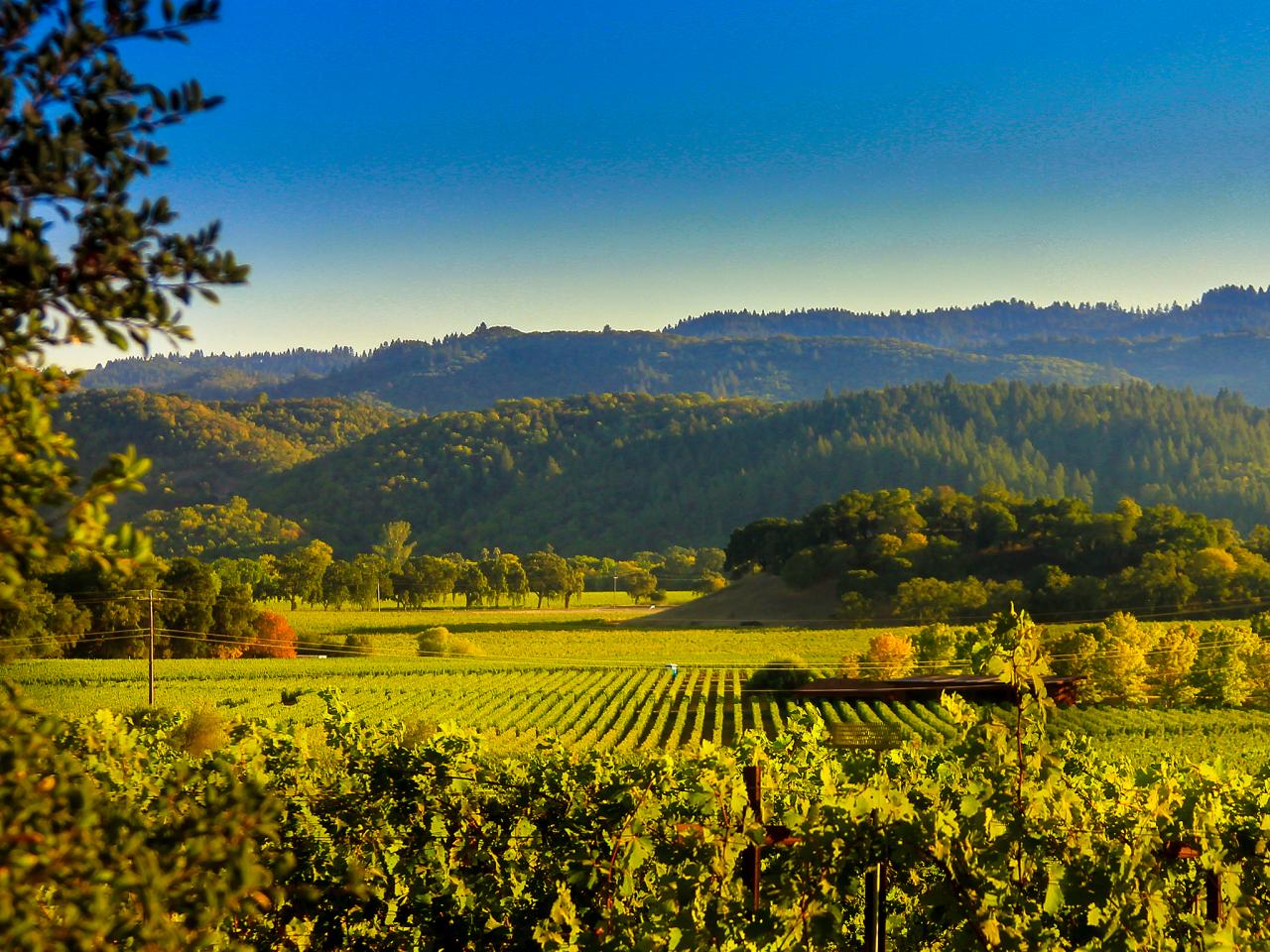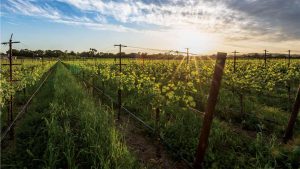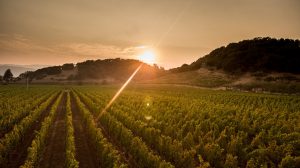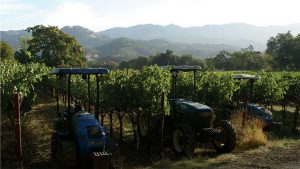
There are 16 distinct appellations located in the Napa Valley. These districts are known as American Viticulture Areas, also referred to as AVAs. An area of land is classified as its own AVA when it has scientifically distinguishable geographic and climate characteristics that qualify the area as a completely unique grape-growing region. This goes to show how diverse Napa Valley is in its entirety considering there are 16 different appellations. With so many different AVAs to choose from, it can be tough to determine which appellation is right for you. Each AVA offers a different wine growing experience, so it really comes down to your palate to understand which AVA might be your favorite. Take a look at what each AVA has to offer and maybe you will be able to determine which one matches your taste buds!

Los Carneros
Starting in the most southern region, Los Carneros offers the cool breeze of the San Pablo Bay. These conditions are most ideal for fruit-forward, lighter wines such as Pinot Noirs, Merlot, Syrah, and Chardonnay. This is the location of Baldacci Family Vineyard’s Honey B estate where we grow these exact wines along with a Late Harvest Gewurztraminer.
Coombsville
Coombsville is the newest member of the Napa Valley AVAs. It was established in 2011 and is known to be one of the most up-and-coming regions for Cabernet Sauvignon in the valley. While Cabernet Sauvignon covers the hillsides of this AVA, it is also great for growing Pinot Noirs, Syrah, Merlot, and Chardonnay in the flatter, cooler regions of it. Baldacci has sourced grapes from Coombsville for nearly 20 years to make our membership only Ruppert Cabernet Sauvignon.
Wild Horse Valley
Just east of Coombsville is the Wild Horse Valley AVA. This AVA offers a warmer climate and higher elevation that is great for Pinot Noir. Cabernet Sauvignon and Chardonnay can also be found growing in this region. This AVA is just a small piece of Napa County with the other eastern half dipping into Solano County.
Mount Veeder
This appellation is one of the higher elevation regions with most wineries growing above the fog line. This makes for warmer nights and cooler days. With the volcanic soils of the Mayacamus Mountains, it offers fantastic conditions for Cabernet Sauvignon. Zinfandel, Merlot, and Chardonnay can also be found being grown in this AVA.
Oak Knoll District of Napa Valley
Being towards the middle of the valley, a majority of the fog tends to roll into Oak Knoll and linger there. With the moderate to cool temperatures, it is more common to see luscious Pinot Noirs and Chardonnays growing in this region. This AVA offers plenty of variety with Cabernet Sauvignon, Cabernet Franc, Merlot, and Malbec also being grown in the area.
Yountville
When people hear Yountville, they often think of the quaint little town where the French Laundry is located. However, it is also a fantastic growing region as well! This too is a region where fog heavily benefits the growing process. Cabernet Sauvignon dominates the area with some Merlot being grown there as well.

Stags Leap District
Cab is king in the Stags Leap District! The AVA sits on the eastern side of the Valley floor and meanders along the Silverado Trail with the Vaca Mountain range to the east. Much of the sun radiates off the dark rocks of the hillside creating exceptionally warm conditions ideal for growing a richly textured Cabernet Sauvignon with blackcurrant flavors. Merlot, Chardonnay, and Sauvignon Blanc can also be found in this region. This is the main estate Baldacci Family Vineyards operates out of and we dedicate all 20 acres of farmland to growing richly crafted Cabernet Sauvignon.
Atlas Peak
To the east of the Stags Leap District sits Atlas Peak. The elevation can go as high as 2,600 feet which can create cooler temperatures. It is rare to find a day during the summer that is hotter than 90 degrees Fahrenheit. This large AVA dedicates most of its resources to growing Cabernet Sauvignon that is a finer style than the typical muscular cabs of Napa Valley. It also is a great region for producing Zinfandel and Chardonnay.
Oakville
The Oakville AVA is just north of the Stags Leap District. Being such close neighbors, it is not a surprise to most that Cabernet Sauvignon is also the main varietal grown in this region. The warm temperatures allow for deep, richly flavored wines. Merlot is another varietal that can be often found growing in this region. Baldacci Family Vineyards sources grapes from this AVA to create our Oakville Cabernet Sauvignon – one of the more elegant Cabernet Sauvignons in our portfolio.
Rutherford
Continuing north up the valley you hit the AVA of Rutherford. Rutherford offers long summer days and organic, earthy growing conditions for creating tannic Cabernet Sauvignons. It also offers terrific conditions for growing Merlot, Malbec, Cabernet Franc, and Petit Verdot. This AVA is often considered the center of the Napa Valley.
St. Helena
As you move further North, St. Helena emerges as yet a warmer growing region as well as being located in the narrowest part of the Valley. It sits at an elevation between 100- 700 feet and is another phenomenal AVA for growing Cabernet Sauvignon. These conditions create richly structured Zinfandel and Merlot wines as well.
Spring Mountain District
This AVA sits in the middle of the Mayacamus Mountains. Volcanic and sandstone soils fill the area to create ideal conditions for Cabernet Sauvignon. The cool weather helps produce a wine with softer tannin structures and big fruit flavors. Cabernet Franc, Chardonnay, and Zinfandel can also be found being grown in this AVA.
Chiles Valley District
This is another AVA that sits at a high elevation causing for a cooler climate. It is a thinly sliced piece of land lying in the upper eastern region of Napa Valley. The cool weather combined with the earthy soil of the Vaca Mountains makes for terrific conditions to grow Zinfandel.
Howell Mountain
Just west of the Chiles Valley District is Howell Mountain. Contrary to Chiles Valley District, this AVA is at a much higher altitude with much warmer weather. It is known as one of the most prestigious hillside AVAs for its warm conditions allowing the grapes to develop intense flavors and aromatic depth. Cabernet Sauvignon is the primary varietal grown in this AVA with some Merlot and Zinfandel grown as well. Baldacci Family Vineyards sources grapes from this region to create our Howell Mountain Cabernet Sauvignon – know for its big, bold, full-bodied flavors.
Diamond Mountain
Another relatively high altitude appellation with cooler conditions. The Diamond Mountain AVA gets its distinct flavors due to rocky, infertile slopes that allow for a perfect level of stress on the vines. The grape production can be small in yield but big in flavor. Cabernet Sauvignon takes up nearly 90% of all wine grown in this region.

Calistoga
Finally, making it to the most northern region of the Napa Valley you hit Calistoga. This AVA is well-worth the trek if you are coming from the south. Calistoga is known for being the warmest AVA in Napa Valley as well as the most topographically diverse. With such rich soil and warm weather, it should be needless to say that Calistoga produces big, bold red wines full of texture and depth. Cabernet Sauvignon is the main varietal grown in this AVA but it is also terrific for growing Zinfandel and Petit Syrah. Baldacci Family Vineyards’ Stella Knight estate sits in Calistoga where we focus on growing tannic, beautiful red berry Cabernet Sauvignon.
Other resources:
Visit Napa Valley and its appellations
Download the Napa Vintners Appellation Map